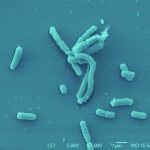Lien vers Pubmed [PMID] – 17238929
Mol. Microbiol. 2007 Feb;63(4):1145-57
Yersinia pestis, the plague bacillus, has an exceptional pathogenicity but the factors responsible for its extreme virulence are still unknown. A genome comparison with its less virulent ancestor Yersinia pseudotuberculosis identified a few Y. pestis-specific regions acquired after their divergence. One of them potentially encodes a prophage (YpfPhi), similar to filamentous phages associated with virulence in other pathogens. We show here that YpfPhi forms filamentous phage particles infectious for other Y. pestis isolates. Although it was previously suggested that YpfPhi is restricted to the Orientalis branch, our results indicate that it was acquired by the Y. pestis ancestor. In Antiqua and Medievalis strains, YpfPhi genome forms an unstable episome whereas in Orientalis isolates it is stably integrated as tandem repeats. Deletion of the YpfPhi genome does not affect Y. pestis ability to colonize and block the flea proventriculus, but results in an alteration of Y. pestis pathogenicity in mice. Our results show that transformation of Y. pestis from a classical enteropathogen to the highly virulent plague bacillus was accompanied by the acquisition of an unstable filamentous phage. Continued maintenance of YpfPhi despite its high in vitro instability suggests that it confers selective advantages to Y. pestis under natural conditions.

